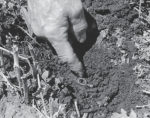Advertise Follow Us
Articles Tagged with ''anhydrous''
Variable Rates Pay Off For Nebraska No-Tiller
An Exactrix wing injection system cuts nitrogen rates by 70 pounds per acre with no seedbed disturbance.
Read More
No-Tilling Into Live Cover Crops Could Mean Early Seeding Benefits
Experimental system could protect soil and moisture while overcoming the problems of cold, wet ground.
Read More
What I've Learned from No-Tilling
Crop Value Rather Than Top Yield Matters In This No-Till Operation
What this husband and wife team saw immediately with no-till was that they had more money in the bank at the end of the year.
Read More
Developing An Anhydrous Strategy Can Cut Costs And Boost Profits
Knowing the precise amount needed and stabilizing nitrogen to avoid losses creates an efficient no-till fertilizer program.
Read More
Maximize Your Phosphorus Placement
Input costs for fertilizer, an absolute necessity, can be staggering. Here’s how to ensure you get the biggest bang for your phosphorus buck.
Read More
No-Till’s Greatest Allies
If you’re wondering how earthworms might be doing in your no-tilled soils, this researcher may surprise you with his results.
Read More
Looking Down On Soil Life
What goes on in the top 2 inches of your no-tilled soil is especially important after the growing season.
Read More
Maximize Your No-Till Nitrogen
When it comes to harvesting more bushels of no-tilled corn from your nitrogen, the use of stabilizers are a good investment.
Read More
Five Fewer Trips Saves Driving Over 11,500 Acres!
Labor, fuel and equipment are sharply reduced with this Canadian’s no-till program.
Read More









